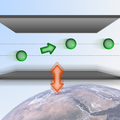Scientific instrument developed at TUM enables publication in Nature Physics
Probing the Laws of Gravity: A Gravity Resonance Method

A vibrating plate excites neutrons in the earth's gravitational field from one quantum state into the other (Copyright: TU Vienna).
18.04.2011, News
Quantum mechanical methods can now be used to study gravity: With the help of a scientific instrument developed at Technische Universitaet Muenchen (TUM) and the cluster of excellence “Universe”, scientists at the Vienna University of Technology (TU Vienna) found a measurement method, which allows to test the fundamental theories of physics. The results are published in the current online issue of Nature Physics.
The world’s most precise measurement methods are based on
quantum physics. Atomic clocks or high-resolution magnetic resonance, which is
used in medicine, rely on accurate measurements of quantum leaps: A particle
excited at exactly the right frequency changes its quantum state – this is
called “resonance spectroscopy”. Up until now, this method has only been used
employing electromagnetic radiation. Researchers at TU Vienna have now
developed a resonance method, which for the first time does not use
electromagnetism, but the force of gravity. Gravity creates several possible
quantum states for neutrons. The Gravity Resonance Method now allows to induce
and accurately measure transitions between these states. The results of these
experiments have now been published in the scientific journal “Nature Physics”.
At first glance, gravity and quantum physics do not appear
to have much in common. We can feel gravity, when huge, heavy objects, such as
stars or planets are involved. Quantum particles on the other hand are so light
that gravity usually does not play a major role in describing them. The new
method now links those two areas – now, the theory of gravity can be probed at
minute distances. This way, scientists hope to gain insight into string theory
or the nature of dark matter. So far, gravity research was limited to
macroscopic or even astronomical distances.
It is hard to measure the quantum physical effects of
gravity at tiny length scales. “Atoms should better not be used for such
experiments, because their behaviour is strongly influenced by short-range
electromagnetic forces – such as the Van-der-Waals-force or the Casimir force”,
Professor Hartmut Abele form the TU Vienna explains. He had developed the
instrument for the measurements at TUM. “But with our ultra-cold neutrons,
which are uncharged and hardly polarizable, we can do high-precision
measurements at short distances.”
We can lift up a stone to an arbitrary height – the higher
we lift it, the more energy we have to spend. For quantum particles like
neutrons, travelling between two horizontal plates, this is different: they can
only take up discrete portions of gravitational energy. Using the neutron
source of the Institut Laue-Langevin in Grenoble, the Vienna scientists managed
to precisely define the quantum physical energy state of the neutrons between
two plates. One of the plates was then vibrated at a precisely controlled
frequency. If this frequency corresponds to the energy difference between two quantum
states, the neutron is excited into the higher energy state. Measuring at which
frequency this excitation takes places therefore reveals the exact energy
difference between the quantum states.
Massive objects have two fundamental properties: They are
inert (large forces are needed to accelerate them), and they are heavy (a
strong gravitational force acts on them). Already in the 16th century, it was
known that inertia and weight go together, and that this causes all objects to
fall to the ground at the same speed. Whether this is only a good
approximation, or whether this is also true at the minute length scales of
quantum physics can now be investigated with the newly developed experiments.
For decades, physicists have been struggling to unify gravitation
and quantum physics, creating a unified theory of everything. Different string
theories have been developed, predicting the existence of hidden spatial
dimensions, which have not yet been discovered. “Using our neutron method, we
will try to test such theories in the laboratory”, professor Hartmut Abele
announces. Even for cosmology, these experiments may play an important role.
Theories about the mysterious “dark matter”, which is considered to govern the
motion of galaxies, could now be investigated on tiny scales with
high-precision measurements. “Our method, which is specially designed for
minute length scales, could – if we are lucky – help us understand the
evolution of the universe itself. In any case, thrilling new insights in
gravity research are awaiting us”, says professor Abele.
Original publication:
Tobias Jenke, Peter Geltenbort, Hartmut Lemmel and Hartmut
Abele: Realization of a gravity-resonance-spectroscopy technique. Nature
Physics online, 17 April 2011 (DOI: 10.1038/nphys1970)
Pictures free of charge:
http://tuweb.tuwien.ac.at/index.php?id=11249
Press release of TU Vienna:
http://www.tuwien.ac.at/news/news_detail/article/6963//EN/
Kontakt: presse@tum.de



